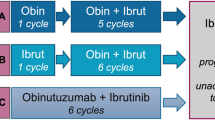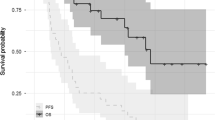Abstract
Bryostatin 1 is a novel antitumour agent derived from Bugula neritina of the marine phylum Ectoprocta. Nineteen patients with advanced solid tumours were entered into a phase I study to evaluate the toxicity and biological effects of bryostatin 1. Bryostatin 1 was given as a one hour intravenous infusion at the beginning of each 2 week treatment cycle. A maximum of three treatment cycles were given. Doses were escalated in steps from 5 to 65 micrograms m-2 in successive patient groups. The maximum tolerated dose was 50 micrograms m-2. Myalgia was the dose limiting toxicity and was of WHO grade 3 in all three patients treated at 65 micrograms m-2. Flu-like symptoms were common but were of maximum WHO grade 2. Hypotension, of maximum WHO grade 1, occurred in six patients treated at doses up to and including 20 micrograms m-2 and may not have been attributable to treatment with bryostatin 1. Cellulitis and thrombophlebitis occurred at the bryostatin 1 infusion site of patients treated at all dose levels up to 50 micrograms m-2, attributable to the 60% ethanol diluent in the bryostatin 1 infusion. Subsequent patients treated at 50 and 65 micrograms m-2 received treatment with an intravenous normal saline flush and they did not develop these complications. Significant decreases of the platelet count and total leucocyte, neutrophil and lymphocyte counts were seen in the first 24 h after treatment at the dose of 65 micrograms m-2. Immediate decreases in haemoglobin of up to 1.9g dl-1 were also noted in patients treated with 65 micrograms m-2, in the absence of clinical evidence of bleeding or haemodynamic compromise. No effect was observed on the incidence of haemopoietic progenitor cells in the marrow. Some patients' neutrophils demonstrated enhanced superoxide radical formation in response to in vitro stimulation with opsonised zymosan (a bacterial polysaccharide) but in the absence of this additional stimulus, no bryostatin 1 effect was observed. Lymphocyte natural killing activity was decreased 2 h after treatment with bryostatin 1, but the effect was not consistently seen 24 h or 7 days later. With the dose schedule examined no antitumour effects were observed. We recommend that bryostatin 1 is used at a dose of 35 to 50 micrograms m-2 two weekly in phase II studies in patients with malignancies including lymphoma, leukaemia, melanoma or hypernephroma, for which pre-clinical investigations suggest antitumour activity.
This is a preview of subscription content, access via your institution
Access options
Subscribe to this journal
Receive 24 print issues and online access
$259.00 per year
only $10.79 per issue
Buy this article
- Purchase on Springer Link
- Instant access to full article PDF
Prices may be subject to local taxes which are calculated during checkout
Similar content being viewed by others
Author information
Authors and Affiliations
Rights and permissions
About this article
Cite this article
Prendiville, J., Crowther, D., Thatcher, N. et al. A phase I study of intravenous bryostatin 1 in patients with advanced cancer. Br J Cancer 68, 418–424 (1993). https://doi.org/10.1038/bjc.1993.352
Issue Date:
DOI: https://doi.org/10.1038/bjc.1993.352
This article is cited by
-
Cancer Biomarkers for Integrative Oncology
Current Oncology Reports (2019)
-
Bryostatin-1 causes radiosensitization of BMG-1 malignant glioma cells through differential activation of protein kinase-Cδ not evident in the non-malignant AA8 fibroblasts
Molecular and Cellular Biochemistry (2015)
-
Phase I study of bryostatin 1, a protein kinase C modulator, preceding cisplatin in patients with refractory non-hematologic tumors
Cancer Chemotherapy and Pharmacology (2009)
-
Targeting the protein kinase C family: are we there yet?
Nature Reviews Cancer (2007)
-
A phase II trial of bryostatin-1 administered by weekly 24-hour infusion in recurrent epithelial ovarian carcinoma
British Journal of Cancer (2003)



